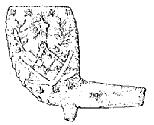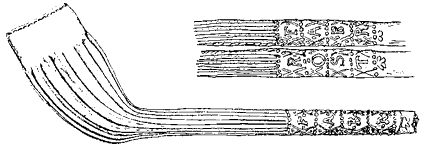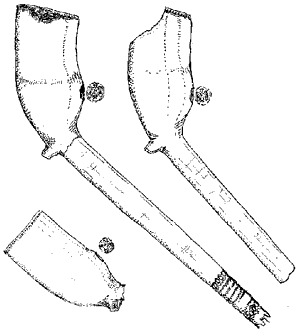No. 6/1992, p. 1-11
Bernd Standke: Clay-pipe finds in Freiberg
An account is given of clay-pipe assemblages which were found during
excavations in the centre of Freiberg, Saxony. Most of the pipes
are imports from Gouda or 18th century pipes modelled on Gouda types.
It is clear from a few specimens dating from before 1700 that pipes
were smoked in Saxony as early as this. Some pipes have ornamentation
and inscriptions which suggest that they were manufactured specially
for Saxony; in one case a pipe bowl shows two miners and the word
"FREIBERG". Unfortunately, we don't yet know where the
pipes were made (apart from Gouda); however, Altstadt-Waldenburg,
which is near Freiberg, is one possibility. A "coffee-house"
pipe (19th century) was possibly made in the Westerwald.
|
|
|
|
Pipe with heel showing coat of arms of Great Britain, Waldenburg,
mid 18th century
|
Heelless ribbed pipe with mark '6', Saxony, mid 18th century
|
Pipe with heel, shows two miners smoking and the inscription
FREIBERG, probably from Saxony, 18th century
|

|
|
|

|
No. 6/1992, p. 12 ff.
Rüdiger J.J. Articus: A pipe bearing masonic symbols
|
A clay pipe found at Bullenhausen, Harburg district, shows
the masonic insignia on the bowl. There was a freemason's lodge
in Harburg and it is possible that this pipe belonged to one
of the members. The symbols, however, are not specifically connected
with one particular lodge. The pipe is closely comparable with
specimens from Holland and the Westerwald, and a more or less
identical model is figured in catalogues of several clay-pipe
factories from there.
Two pipes showing Masonic symbols,
provenance unknown, 1890-1940
|
|
 |

|
|
No. 6/1992, p. 15-20
Edward Zimmermann/Martin Kügler: Maker's marks on pipes
from the clay-pipe factory at Rostin
An account is given of the marks used in the clay-pipe factory at
Rostin in Poland (then in Prussia). The factory began production
just before 1750. Business didn't begin to flourish until around
1755 when a merchant called Isaac Salingre or Salinger acquired
the factory. The shape of the pipe bowls and the marks were modelled
on Gouda pipes, but the inscriptions on the pipe stems normally
give the (correct) maker's name. All marks known so far that were
used in this factory between 1750 and the beginning of the 19th
century are figured.

Clay pipes from the factory in Rostin (see inscription),
second half of 18th century

No. 6/1992, p. 21 f.
Andreas Eiynck: A clay-pipe factory in Aschendorf near Papenburg
The clay-pipe factory in Papenburg mentioned in KnasterKOPF No.
3/1990, p. 31, can now be described in more detail. The factory
was situated in Aschendorf near Papenburg, but nothing remains of
it today. Documentary evidence shows that it existed at least between
1832 and 1905. Nothing is known yet about the products of the factory.

No. 6/1992, p. 22 f.
Reg Jackson / Philomena Jackson: International Clay-Pipe Research
- "The Society for Clay Pipe Research"
European clay tobacco pipes were first produced in England during
the late 16th century. Thus it is appropriate that England should
have been the birthplace of some of the earliest researches on the
subject of clay pipe production. In 1974 the publication of Adrian
Oswald´s book "Clay Pipes for the Archaeologist"
acted as an inspiration for many people to untertake research in
their own areas to find historical data about when and where pipes
were produced, who made them, and how they were manufactured and
distributed. So the Society for Clay Pipe Reseach was founded in
1983 following the production of a trial Newsletter. The SCPR now
has about 150 members worldwide and membership is open to all those
who are interested in the study of clay tobacco pipes.

No. 6/1992, p. 24-33
Pieter Smiesing: Clay-pipe finds in Hamburg
 |
|
Clay-pipe fragments from an excavation on the Venusberg (Böhmkenstrasse),
Hamburg, were given to the author in 1981. On the basis of dates
on the associated earthenware plates, and from the lack of a
Gouda coat-of-arms mark on the pipe bowls, the pipes are dated
between 1713 and 1739. They were probably made in Gouda. The
unusually large size of some of the bowls is not incompatible
with this, and may point to an exception to Friedrich´s
theory of continually increasing volume of the bowl with decreasing
age. The group includes a black-fired pipe, which is a rare
occurrence.
Pipes with heel, the lips of the bowls show rouletting,
probably Gouda, beginning of 18th century
|
|
|
